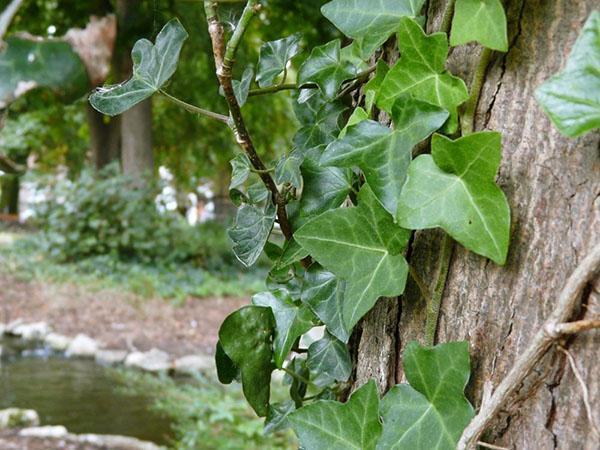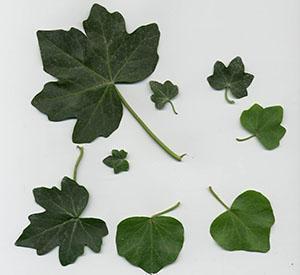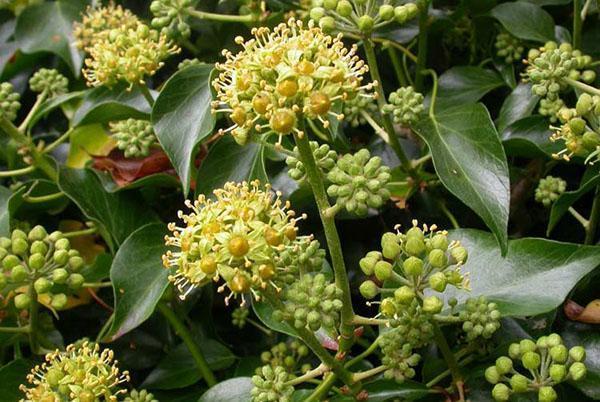Planting, care and reproduction of garden ivy
 For residents of the middle zone of the heder, unpretentious evergreen ivy is more familiar as a popular ampelous plant for the home. But in the southern regions of the country it is garden ivy.
For residents of the middle zone of the heder, unpretentious evergreen ivy is more familiar as a popular ampelous plant for the home. But in the southern regions of the country it is garden ivy.
Huge thickets of this culture can be found in the Crimea and the Caucasus. Growing up, ivy climbs the inaccessible tales, the walls of houses, covers the slopes with a dense carpet, its shoots hang from the trees. Plants belonging to perennial evergreen vines are not capricious, not demanding on growing conditions and care. They grow quickly and willingly delight with decorative foliage of various shapes and colors.
It is not surprising that the plant was noticed by gardeners for a very long time. In Europe, evergreen garden ivy, which remains attractive throughout the year, is used to decorate hedges, landscaping of urban and rural buildings, parks and gazebos.
Description of garden ivy and cultivated species

The leaves, depending on the type of garden ivy, can be either split, three- or five-toed, or whole. The leaf blades of most garden ivy are dense, leathery with a smooth surface and radially diverging veins. In addition to plants with monochromatic, green foliage, variegated specimens can be seen even in the wild.
 If the long shoots reaching 30 meters in length and ornamental foliage of garden ivy are immediately striking, then the flowering of representatives of this genus sometimes goes unnoticed. Collected in capitate or umbellate inflorescences, greenish flowers are very small and do not represent decorative value.
If the long shoots reaching 30 meters in length and ornamental foliage of garden ivy are immediately striking, then the flowering of representatives of this genus sometimes goes unnoticed. Collected in capitate or umbellate inflorescences, greenish flowers are very small and do not represent decorative value.
 Small rounded fruits of a dark, almost black color formed after pollination look much more interesting.
Small rounded fruits of a dark, almost black color formed after pollination look much more interesting.
In culture on the territory of Russia, only a few, the most cold-resistant species are grown:
- Orchard ivy is the most common plant and is also used as a houseplant. This species is distinguished by a slow growth rate, comparatively medium-sized three- or five-toed leaf plates and an abundance of varieties.
- Colchis or Caucasian ivy also grows in gardens. A strong, fast-growing liana with shoots up to 30 meters long and leaves sometimes reaching 20 cm in diameter, is found naturally in the foothills of the Caucasus, as well as in a number of Asian regions. The shape of green or variegated leaves changes as they grow.
- Crimean ivy is another Russian species that outwardly resembles the Maltese variety grown in Europe. Heat-loving plants, getting into favorable conditions, become powerful. Their trunks at the base become lignified, sometimes growing together with the trees, which this garden ivy willingly climbs.
Planting and caring for garden ivy
 Ivy is considered to be a shade-tolerant crop that easily adapts to life as a ground cover plant. Settling under the crowns of large trees in the southern regions, it winters well. But the further north, the higher the risk of freezing, not only due to low temperatures, but also due to high humidity, insufficient shelter.
Ivy is considered to be a shade-tolerant crop that easily adapts to life as a ground cover plant. Settling under the crowns of large trees in the southern regions, it winters well. But the further north, the higher the risk of freezing, not only due to low temperatures, but also due to high humidity, insufficient shelter.
To protect the plant and make it easier to care for garden ivy, planting is carried out in elevated, sheltered from the wind.The first few years, the culture does not grow too quickly, so young ivy is planted in the spring, so that the seedlings ripen during the warm season and winter better. For ivy propagation, choose healthy shoots no older than 2-3 years. In this case, they will take root well, they will not have to be seriously injured when transferred to a new place.
 Garden-friendly ivy is not overly capricious and adaptable. To make this happen faster, a moisture-consuming, breathable substrate with a high organic content is prepared for planting. The main part of ivy roots is located at a depth of 20 cm, so the planting pit is prepared a little deeper. A drainage layer is required at the bottom.
Garden-friendly ivy is not overly capricious and adaptable. To make this happen faster, a moisture-consuming, breathable substrate with a high organic content is prepared for planting. The main part of ivy roots is located at a depth of 20 cm, so the planting pit is prepared a little deeper. A drainage layer is required at the bottom.
After planting garden ivy, care consists in watering, feeding and in simple tillage. Very careful loosening will help to increase the permeability of the soil to air and moisture, and mulching can save moisture and protect the plants from the first frost by winter.
The soil is loosened to avoid the formation of a dense crust after rain, trying not to harm the shoots and their adventitious roots, which are formed closer to the nodes and quickly penetrate into the substrate as they grow.
Mulching with leaf humus, peat, or other porous organic matter prevents the soil from drying out, and in wet years and from decay. Mulch is poured gradually, in a thin layer in several steps, so as not to affect the foliage located near the ground. By autumn, the layer is increased in order to carry out a full-scale insulation and shelter of plants with the arrival of cold weather.
The farther north, the greater the likelihood of freezing of plants used for vertical gardening. This fully applies to ivy for hedges, arches and walls of houses. Ground cover specimens, especially those additionally covered with snow, winter better.
 After the snow melts in the spring, you should not rush to prune shoots affected by frost or for other reasons. It is better to remove them in early summer, when the active movement of juices ends. Sections on large stems are treated with garden pitch.
After the snow melts in the spring, you should not rush to prune shoots affected by frost or for other reasons. It is better to remove them in early summer, when the active movement of juices ends. Sections on large stems are treated with garden pitch.
Water your garden ivy regularly throughout the season, but in moderation, keeping an eye on the soil moisture under the plants.
Breeding evergreen ivy
Most gardenable species form adventitious or aerial roots. This makes it easy to root cuttings cut in the spring and summer months.
 For ivy propagation, semi-lignified shoots with visible rudiments or already real adventitious roots are suitable. If you cut off a very young, green growth, the rooting process takes much longer. And under unfavorable conditions, for example, in the coolness, the stalk can completely rot.
For ivy propagation, semi-lignified shoots with visible rudiments or already real adventitious roots are suitable. If you cut off a very young, green growth, the rooting process takes much longer. And under unfavorable conditions, for example, in the coolness, the stalk can completely rot.
 For propagation of evergreen ivy, it is better to use apical cuttings, but if this is not possible or you need to get a lot of young plants, the shoot is cut into 10 cm pieces, with at least one healthy node.
For propagation of evergreen ivy, it is better to use apical cuttings, but if this is not possible or you need to get a lot of young plants, the shoot is cut into 10 cm pieces, with at least one healthy node.
You can root the cuttings in an outdoor greenhouse by planting several pieces in loose light soil, or in plain water. When a sufficient number of roots appear on the stems, the plants are transferred to the future residence. Given the growth of ground cover shrubs and the peculiarities of caring for garden ivy, planting is carried out at a distance of at least half a meter from each other.
What is the name of this rose?
What kind of ivy can I grow in my garden without any problems? Central strip. Bryansk.
Choose any variety and just follow the planting and care rules. The plant itself is unpretentious; it just grows faster in the southern regions. Protect the young plant from severe frosts for the first three years.
Thank you very much for the information!
IVY IS AN ORDINARY PROFESSOR SENETH TO WINTER IN PRIMORSKY REGION?
Like all varieties of common ivy, the variety is characterized by good winter hardiness. If you live in the southern part - yes, but in other regions it all depends on the winter.
You can plant it in a pot on the street, since there is asphalt around, and you really want to cover the wall of the house with ivy.
In principle, it is possible, the root system of ivy is not very deep. At first, a regular pot will do, and over time, just pick up a spacious tub.
Please tell me what kind of ivy is needed to decorate a flowerpot and how to plant and care for it?
Judging by the leaves, you have common ivy. How to care for it as a pot culture is detailed here. https://myvilla.cosmetius.com/en/vyrashhivaem-plyushh-komnatnyy/.
how to plant ivy so that it crawls on the wall of the house, if there is formwork around the house?
If you want ivy to cover the wall from the very base, you have to work a little. You will need a piece of asbestos-cement pipe with a diameter of 15-20 cm and a length to the depth of the laid formwork. A drill is knocked out a hole in the formwork 1-2 cm larger than the outside diameter of the pipe. Insert the pipe and fill it with nutrient soil. Plant ivy. Pour the joint between the pipe and the formwork with cement mortar.
Second option. This is planting ivy right next to the formwork and creating an inclined trellis.
can ivy be planted in August or autumn?
In general, it is possible, but then the plant will have very little time to take root and grow stronger before winter. If it is not possible to postpone planting until spring, try to cover it well before frost.